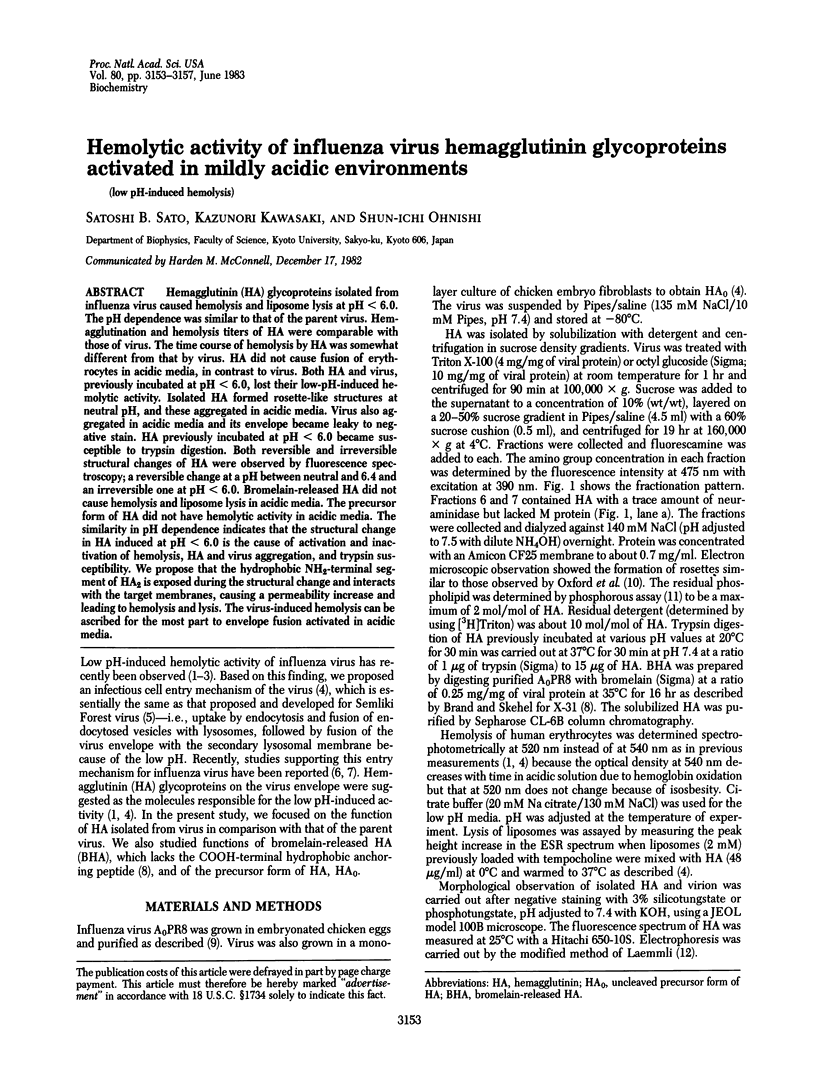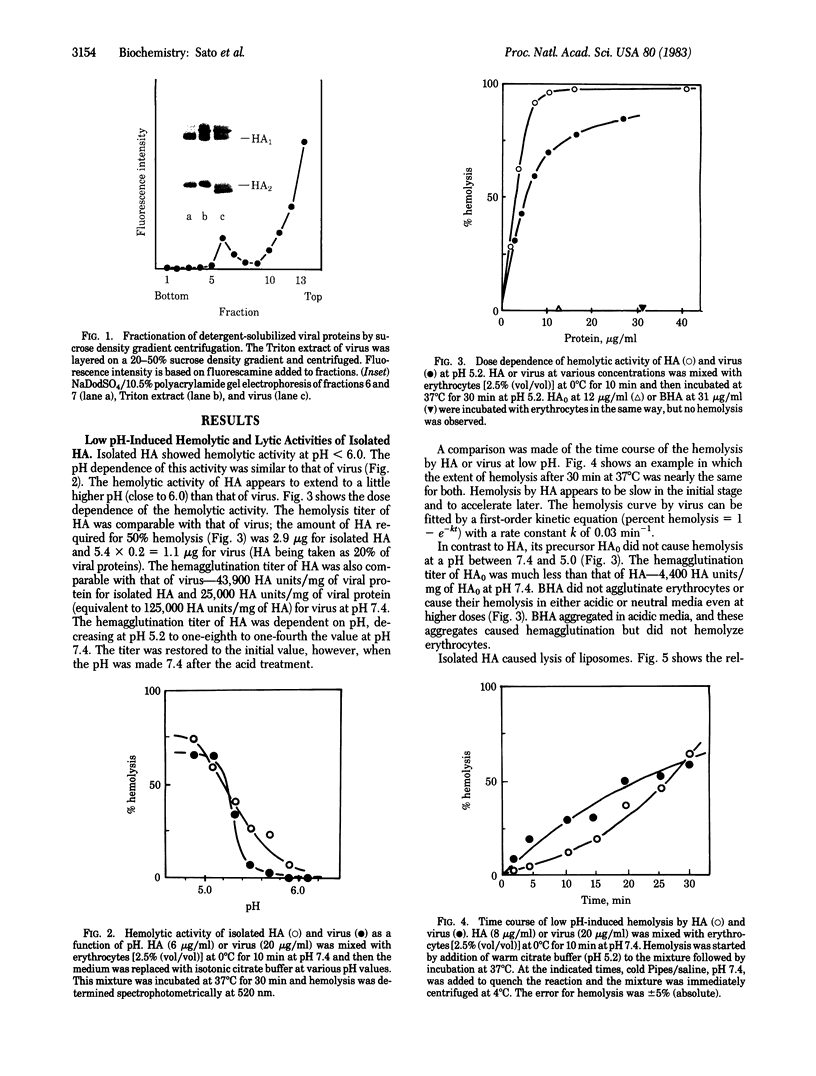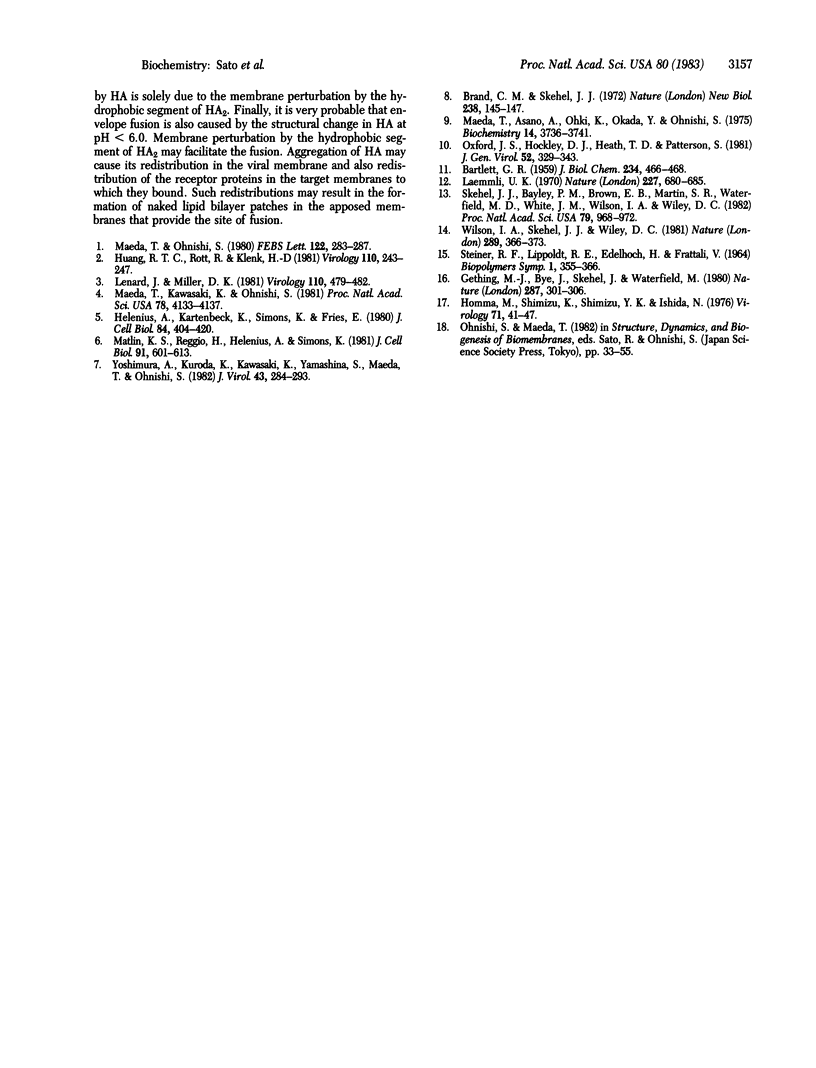Abstract
Hemagglutinin (HA) glycoproteins isolated from influenza virus caused hemolysis and liposome lysis at pH less than 6.0. The pH dependence was similar to that of the parent virus. Hemagglutination and hemolysis titers of HA were comparable with those of virus. The time course of hemolysis by HA was somewhat different from that by virus. HA did not cause fusion of erythrocytes in acidic media, in contrast to virus. Both HA and virus, previously incubated at pH less than 6.0, lost their low-pH-induced hemolytic activity. Isolated HA formed rosette-like structures at neutral pH, and these aggregated in acidic media. Virus also aggregated in acidic media and its envelope became leaky to negative stain. HA previously incubated at pH less than 6.0 became susceptible to trypsin digestion. Both reversible and irreversible structural changes of HA were observed by fluorescence spectroscopy; a reversible change at a pH between neutral and 6.4 and an irreversible one at pH less than 6.0. Bromelain-released HA did not cause hemolysis and liposome lysis in acidic media. The precursor form of HA did not have hemolytic activity in acidic media. The similarity in pH dependence indicates that the structural change in HA induced at pH less than 6.0 is the cause of activation and inactivation of hemolysis, HA and virus aggregation, and trypsin susceptibility. We propose that the hydrophobic NH2-terminal segment of HA2 is exposed during the structural change and interacts with the target membranes, causing a permeability increase and leading to hemolysis and lysis. The virus-induced hemolysis can be ascribed for the most part to envelope fusion activated in acidic media.
Full text
PDF




Images in this article
Selected References
These references are in PubMed. This may not be the complete list of references from this article.
- BARTLETT G. R. Phosphorus assay in column chromatography. J Biol Chem. 1959 Mar;234(3):466–468. [PubMed] [Google Scholar]
- Brand C. M., Skehel J. J. Crystalline antigen from the influenza virus envelope. Nat New Biol. 1972 Aug 2;238(83):145–147. doi: 10.1038/newbio238145a0. [DOI] [PubMed] [Google Scholar]
- Gething M. J., Bye J., Skehel J., Waterfield M. Cloning and DNA sequence of double-stranded copies of haemagglutinin genes from H2 and H3 strains elucidates antigenic shift and drift in human influenza virus. Nature. 1980 Sep 25;287(5780):301–306. doi: 10.1038/287301a0. [DOI] [PubMed] [Google Scholar]
- Helenius A., Kartenbeck J., Simons K., Fries E. On the entry of Semliki forest virus into BHK-21 cells. J Cell Biol. 1980 Feb;84(2):404–420. doi: 10.1083/jcb.84.2.404. [DOI] [PMC free article] [PubMed] [Google Scholar]
- Homma M., Shimizu K., Shimizu Y. K., Ishida N. On the study of Sendai virus hemolysis. I. Complete Sendai virus lacking in hemolytic activity. Virology. 1976 May;71(1):41–47. doi: 10.1016/0042-6822(76)90092-1. [DOI] [PubMed] [Google Scholar]
- Huang R. T., Rott R., Klenk H. D. Influenza viruses cause hemolysis and fusion of cells. Virology. 1981 Apr 15;110(1):243–247. doi: 10.1016/0042-6822(81)90030-1. [DOI] [PubMed] [Google Scholar]
- Laemmli U. K. Cleavage of structural proteins during the assembly of the head of bacteriophage T4. Nature. 1970 Aug 15;227(5259):680–685. doi: 10.1038/227680a0. [DOI] [PubMed] [Google Scholar]
- Lenard J., Miller D. K. pH-dependent hemolysis by influenza, Semliki, Forest virus, and Sendai virus. Virology. 1981 Apr 30;110(2):479–482. doi: 10.1016/0042-6822(81)90079-9. [DOI] [PubMed] [Google Scholar]
- Maeda T., Asano A., Oki K., Okada Y., Onishi S. A spin-label study on fusion of red blood cells induced by hemagglutinating virus of Japan. Biochemistry. 1975 Aug 26;14(17):3736–3741. doi: 10.1021/bi00688a003. [DOI] [PubMed] [Google Scholar]
- Maeda T., Kawasaki K., Ohnishi S. Interaction of influenza virus hemagglutinin with target membrane lipids is a key step in virus-induced hemolysis and fusion at pH 5.2. Proc Natl Acad Sci U S A. 1981 Jul;78(7):4133–4137. doi: 10.1073/pnas.78.7.4133. [DOI] [PMC free article] [PubMed] [Google Scholar]
- Maeda T., Ohnishi S. Activation of influenza virus by acidic media causes hemolysis and fusion of erythrocytes. FEBS Lett. 1980 Dec 29;122(2):283–287. doi: 10.1016/0014-5793(80)80457-1. [DOI] [PubMed] [Google Scholar]
- Matlin K. S., Reggio H., Helenius A., Simons K. Infectious entry pathway of influenza virus in a canine kidney cell line. J Cell Biol. 1981 Dec;91(3 Pt 1):601–613. doi: 10.1083/jcb.91.3.601. [DOI] [PMC free article] [PubMed] [Google Scholar]
- Oxford J. S., Hockley D. J., Heath T. D., Patterson S. The interaction of influenza virus haemagglutinin with phospholipid vesicles - morphological and immunological studies. J Gen Virol. 1981 Feb;52(Pt 2):329–343. doi: 10.1099/0022-1317-52-2-329. [DOI] [PubMed] [Google Scholar]
- STEINER R. F., LIPPOLDT R. E., EDELHOCH H., FRATTALI V. ULTRAVIOLET FLUORESCENCE OF PROTEINS: INFLUENCE OF CONFORMATION AND ENVIRONMENT. Biopolym Symp. 1964;13:355–366. [PubMed] [Google Scholar]
- Skehel J. J., Bayley P. M., Brown E. B., Martin S. R., Waterfield M. D., White J. M., Wilson I. A., Wiley D. C. Changes in the conformation of influenza virus hemagglutinin at the pH optimum of virus-mediated membrane fusion. Proc Natl Acad Sci U S A. 1982 Feb;79(4):968–972. doi: 10.1073/pnas.79.4.968. [DOI] [PMC free article] [PubMed] [Google Scholar]
- Wilson I. A., Skehel J. J., Wiley D. C. Structure of the haemagglutinin membrane glycoprotein of influenza virus at 3 A resolution. Nature. 1981 Jan 29;289(5796):366–373. doi: 10.1038/289366a0. [DOI] [PubMed] [Google Scholar]
- Yoshimura A., Kuroda K., Kawasaki K., Yamashina S., Maeda T., Ohnishi S. Infectious cell entry mechanism of influenza virus. J Virol. 1982 Jul;43(1):284–293. doi: 10.1128/jvi.43.1.284-293.1982. [DOI] [PMC free article] [PubMed] [Google Scholar]




